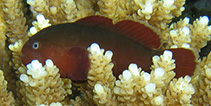| Family: |
Gobiidae (Gobies), subfamily: Gobiinae |
| Max. size: |
3.67 cm SL (male/unsexed) |
| Environment: |
reef-associated; marine |
| Distribution: |
Indo-West Pacific, Red Sea, Japan andn Australia (GBR). |
| Diagnosis: |
Dorsal spines (total): 7-7; Dorsal soft rays (total): 10-10; Anal spines: 1-1; Anal soft rays: 8-8; Vertebrae: 26-26. This species is distinguished by the following characters: D Vi+I,0; A I,8; both head and body naked; distinct groove between isthmus and interopercle; deep body (the depth at pelvic-fin origin 40.4-44.3 % SL) and strongly compressed; juveniles with rounded head, large adults with steep profile, slightly hump-headed; caudal peduncle relatively slender (depth 14.8-16.0% SL); colour of juveniles and adults dark reddish brown with greenish subcutaneous gleam on dorsal part of body; median fins plain (western Pacific Oceans) or with pale margin (Red Sea and Indian Ocean); iris plain light blue (Red Sea) or scattered with red-brown dots on the outer margin (Ref. 94082). |
| Biology: |
Occurs on reef flats, crests and upper reef slopes in less exposed areas; and prefers Acropora selago, but also occurs in a number of other, narrowly branched Acropora species such as A. acuminata and A. hyacinthus (Ref. 94082). |
| IUCN Red List Status: |
Least Concern (LC); Date assessed: 28 June 2018 Ref. (130435)
|
| Threat to humans: |
harmless |
Source and more info: www.fishbase.org. For personal, classroom, and other internal use only. Not for publication.
